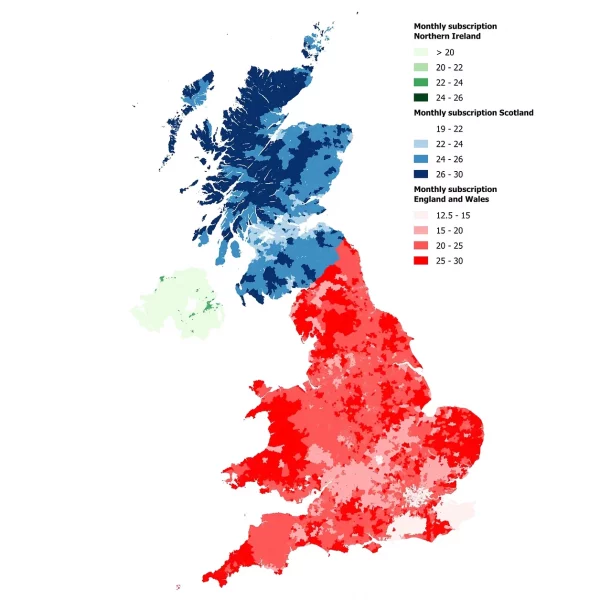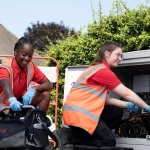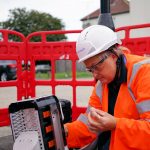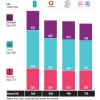Poverty Alliance Claims Millions in UK Choosing Between Broadband and Food

The Digital Poverty Alliance (DPA) has highlighted new data from Point Topic’s UK broadband affordability tracker as helping to show that the “cost-of-living crisis isn’t getting any easier“, with a digital divide still existing that is allegedly “forcing millions to choose between broadband and food.”
First things first, most of our readers will no doubt already be familiar with the fact that you can often access cheaper and faster broadband services in areas of greater physical network competition and thus investment, which typically reflects urban cities and towns. Quite a few rural areas do have access to several competing networks too, but there are often fewer choices and a greater proportion of rural communities remain poorly served with slower connections.
For example, the most recent Connected Nations data from Ofcom (here) noted how gigabit-capable broadband coverage had reached 78% of UK premises by January 2024 (we’re due to get an update on this soon), but this splits down as 84% in urban areas and just 47% in rural areas. The regulator’s Communications Affordability Tracker similarly found that, in July 2024, some 24% of households “struggled to afford their communication services“.
Advertisement
Suffice to say that news of a digital divide is nothing new on these pages. The latest data from Point Topic plays into this a bit by aiming to identify the lowest available broadband subscriptions (‘entry level tariff’) that consumers can access in every postcode, irrespective of broadband technology.
As of November 2024, the lowest available broadband subscription at the postcode level varied from £12.50 to £37.50 per month (FTTP based in both cases). The £12.50 tariff was advertised by CommunityFibre as ‘Essential’ and came with 35Mbps symmetrical speeds on a 12-month contract. It was available in 50,589 postcodes, mainly in London.
However, at the other end of the spectrum, the cheapest broadband available in just two postcodes was £37.50 from Connexin, offering 250Mpbs symmetrical speeds on a 24-month contract (clearly this doesn’t cover every network, as B4RN’s 1Gbps service costs £33 in a fair few rural areas). But, compared to last year, it was found that cheaper broadband tariffs are more widely available across the UK, with the cheapest broadband subscription sitting in the £20 to £24.99 range in 66.3% of “small areas” (up from 31.6% some 12 months ago).
Elizabeth Anderson, CEO of the Digital Poverty Alliance, said:
“As a society, we view areas such as healthcare and education as ‘essential’, yet with these services being increasingly digitised, there remains a lack of affordable connectivity options, especially for those in rural areas. Having access to broadband is all well and good, but there must be a base level of affordability, reliability and connectivity as part of that to ensure that all UK citizens are able to get online.
The cost-of-living crisis isn’t getting any easier for people, and while for many it’s a case of cutting back on spending, it’s forcing millions to choose between broadband and food. A new entitlement, funded by VAT cuts on broadband and mobile bills, can deliver support to millions of households across the country by ensuring that all telecoms providers offer affordable, quality, social tariffs, helping to bridge the digital divide.”
Sadly, the DPA doesn’t provide any solid data to show what proportion of the population is actually making a choice between broadband connectivity and food, but it’s worth noting that this isn’t normally quite such a binary choice – there are many services that can impact the cost of living. Judging something like affordability is similarly difficult because we all have different levels of financial flexibility and different connectivity needs.
Advertisement
Once again, it’s worth remembering that the price we all pay for communication services is largely dwarfed by the hikes in energy (e.g. gas and electricity), petrol, food and other bills. If people are struggling to afford even a fairly basic internet or mobile plan, which doesn’t typically form a large chunk of household bills, then they’ve probably got much bigger concerns in those other areas.
Furthermore, when it comes to broadband, simply having access to an internet connection is something that tends to pay itself back in the value that it generates for end users. This comes from giving you access to compare product prices when shopping, online banking, job hunting, general knowledge and so forth. Put simply, internet connectivity usually saves you more money than the service itself costs to run, often a lot more.
Finally, it’s worth pointing out that the DPA has often called on the UK Government to help support ISPs to get more people in disadvantaged groups online, such as by cutting Value Added Tax (VAT) on broadband ISP and mobile bills to just 5% (currently 20%) – similar to other utility services. But so far there has been no serious push to actually deliver this.
Mark is a professional technology writer, IT consultant and computer engineer from Dorset (England), he also founded ISPreview in 1999 and enjoys analysing the latest telecoms and broadband developments. Find me on X (Twitter), Mastodon, Facebook, BlueSky, Threads.net and Linkedin.
« Netomnia to Build FTTP Broadband into Peabody’s UK Homes























































You can get unlimited 4G/5G data, with tethering, for just £20/month. Or 100GB of data allowance for just £12/month, which will soon be 1 hour’s work at the new minimum wage. Call me insensitive, but I genuinely find it hard to believe that people are going hungry due to paying for connectivity. Housing costs, definitely a major issue – but connectivity? We’re incredibly lucky to have a huge diversity of cheap and abundant data access, compared to swathes of the world.
Not all 4G/5G is fast, though…
It is straight up a bunch of nonsense.
The same people claiming poverty have the iPhone 16 Pro Max, 75″ 4K TV, smoke weed and have no job.
“The same people…”
Sam, I sincerely hope you never find out first hand just how wrong you are.
I 100% agree, we have some of the most affordable broadband in the world. Most suppliers offer a social tariff. The headline stinks, people aren’t choosing between food and broadband.
Sam P: nice parody of what AI trained on the Daily Express would produce. Made me chuckle.
Thanks Ed but no need to worry about me. I’m not some lazy pot head screaming poverty.
I work three different jobs to support my family and keep a roof over their head and put food on the table.
I love how I hit a nerve with some, them acting like I’m some far right bigot.
Reality is that I worked for years with those claiming “poverty” and saw inside their homes.
B4RN also has a social tariff of just £15 for the same gigabit service as their main tariff.
This data misses a big factor. Although an internet service may be cheap – is it fit for purpose? In rural Aberdeenshire (not a remote island) there are premises which have an FTTC connection via Openreach, and of course can get any of the cheap tariffs from the usual ISP’s. But, the connection only provides 1-2Mbps download – simply not fit for purpose. Due to topography and rurality, there this area is a total not-spot for 4G (all MNO’s) and for FWA networks. If these residents need a ‘good’ internet service, then £75 per month for Starlink is sometimes the only option. Suddenly, its not as affordable as people think.
sam p I stand with you 100 percent
Bad map using 3 sets of classes to illustrate the same thing
No one is choosing between broadband and food, even though the government is hellbent on destroying food production and making it more expensive than ever. Insane how fast they deployed Bovaer, despite all the health hazards it has on the NIH website. If they mandate it then not only food becomes less edible but it will also get even more expensive